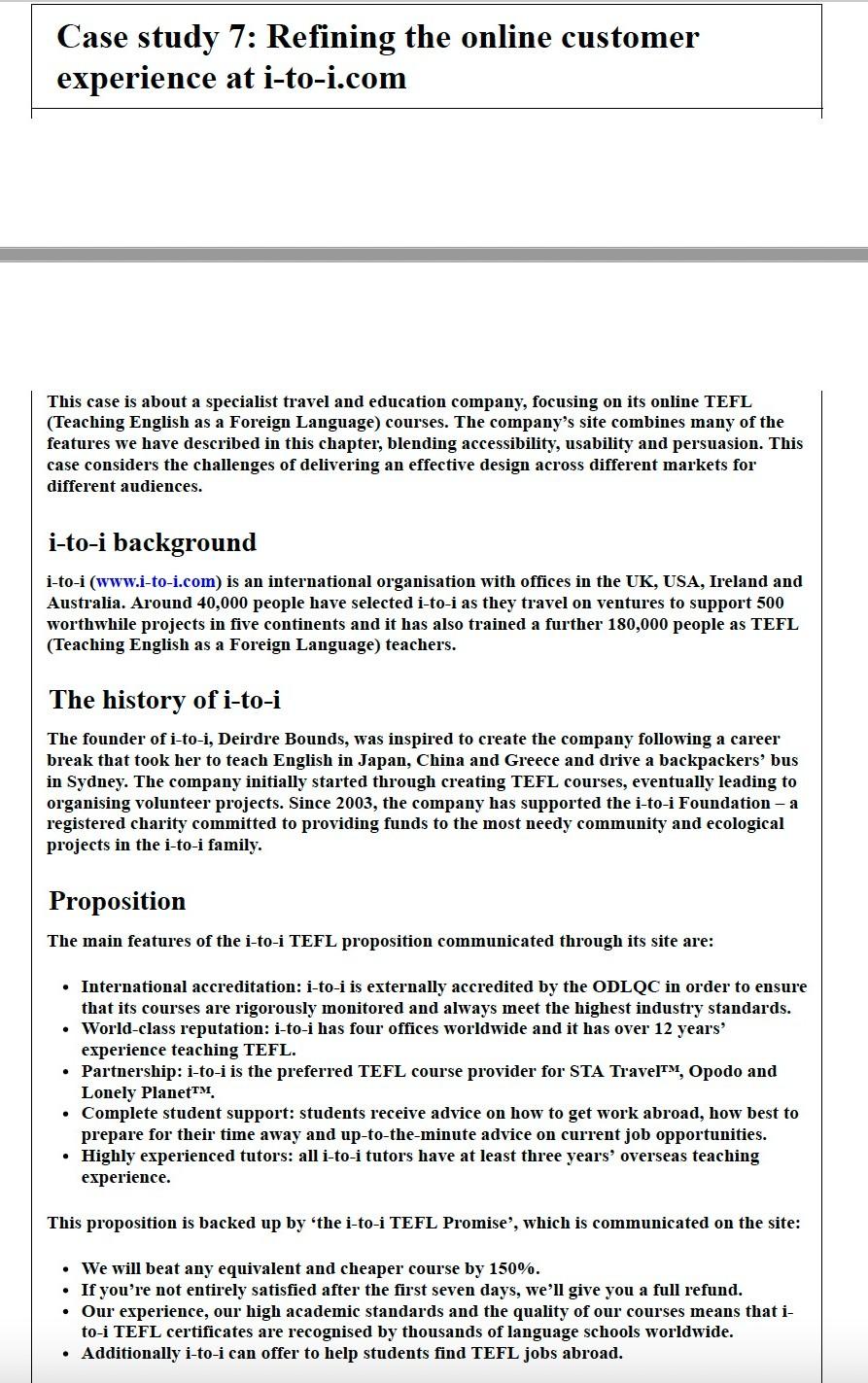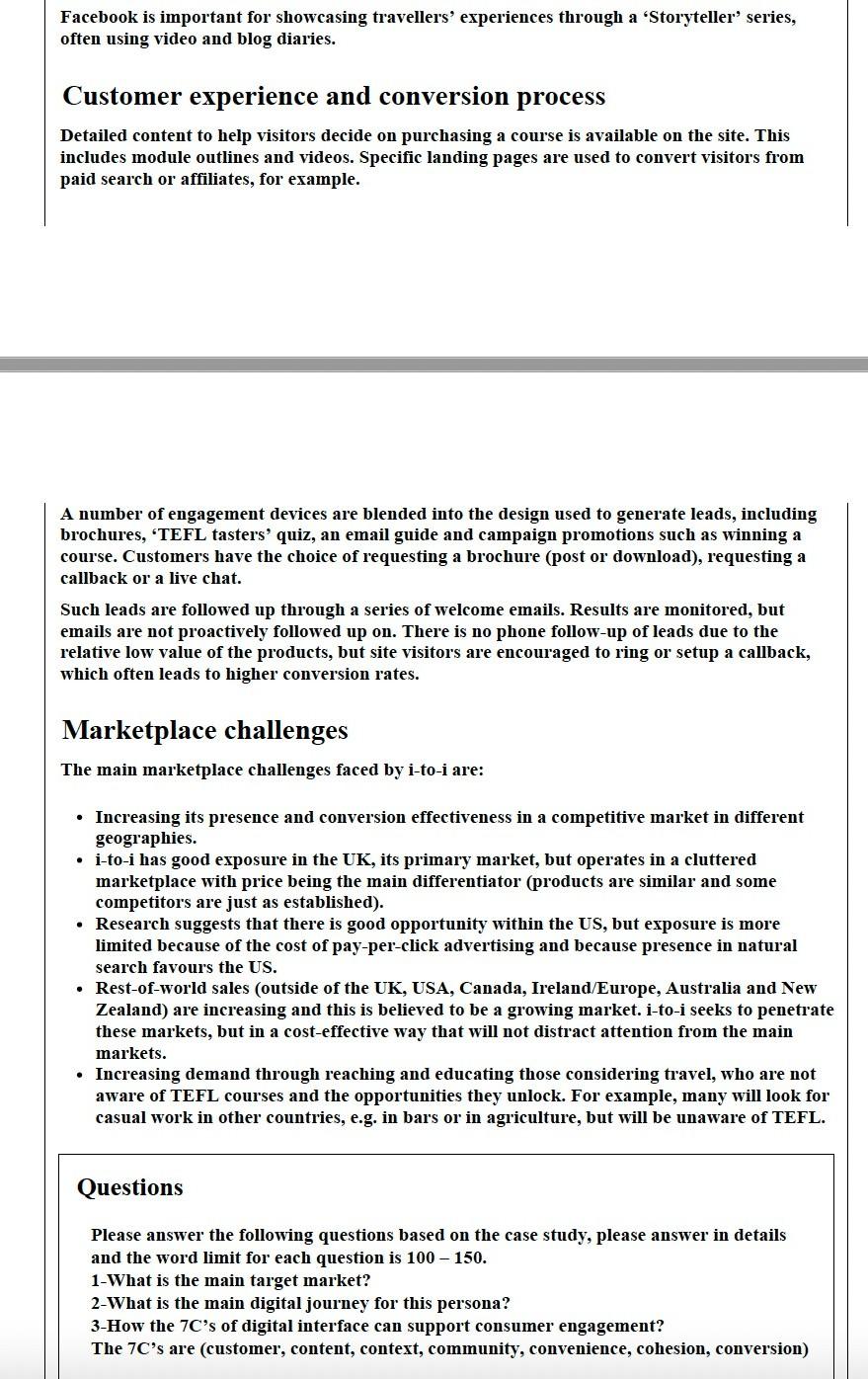Answered step by step
Verified Expert Solution
Question
1 Approved Answer
This case is about a specialist travel and education company, focusing on its online TEFL (Teaching English as a Foreign Language) courses. The company's site



This case is about a specialist travel and education company, focusing on its online TEFL (Teaching English as a Foreign Language) courses. The company's site combines many of the features we have described in this chapter, blending accessibility, usability and persuasion. This case considers the challenges of delivering an effective design across different markets for different audiences. i-to-i background i-to-i (www.i-to-i.com) is an international organisation with offices in the UK, USA, Ireland and Australia. Around 40,000 people have selected i-to-i as they travel on ventures to support 500 worthwhile projects in five continents and it has also trained a further 180,000 people as TEFL (Teaching English as a Foreign Language) teachers. The history of i-to-i The founder of i-to-i, Deirdre Bounds, was inspired to create the company following a career break that took her to teach English in Japan, China and Greece and drive a backpackers' bus in Sydney. The company initially started through creating TEFL courses, eventually leading to organising volunteer projects. Since 2003, the company has supported the i-to-i Foundation - a registered charity committed to providing funds to the most needy community and ecological projects in the i-to-i family. Proposition The main features of the i-to-i TEFL proposition communicated through its site are: - International accreditation: i-to-i is externally accredited by the ODLQC in order to ensure that its courses are rigorously monitored and always meet the highest industry standards. - World-class reputation: i-to-i has four offices worldwide and it has over 12 years' experience teaching TEFL. - Partnership: i-to-i is the preferred TEFL course provider for STA Travel TM, Opodo and Lonely Planet TM. - Complete student support: students receive advice on how to get work abroad, how best to prepare for their time away and up-to-the-minute advice on current job opportunities. - Highly experienced tutors: all i-to-i tutors have at least three years' overseas teaching experience. This proposition is backed up by 'the i-to-i TEFL Promise', which is communicated on the site: - We will beat any equivalent and cheaper course by 150%. - If you're not entirely satisfied after the first seven days, we'll give you a full refund. Audience segmentation The main segmentation used by i-to-i is geographic: - UK; - North America; - Europe; - Australia and New Zealand; - rest-of-world (same as UK). Different brochures are available for each geographical area. Information is also collected on an optional basis about prospects' age and status, although this is not used for targeting emails. Career status categories are: - student; - employed; - self-employed; - career break; - unemployed; - retired. Since optional information is restricted to certain lead tools it is not used to target emails. For weekend TEFL the postcode/city is used to target courses to the nearest location of prospects. Competitors Some of the main competitors for online TEFL courses based in the UK and Australia include: - www.cactustefl.com - www.teflonline.com - www.eslbase.com In the US, competitors who also operate in the UK and other countries include: Media mix i-to-i uses a combination of these digital media channels to drive visits, leads and sales: - pay-per-click (PPC) (mainly Google Ads); - social media marketing using Facebook, Instagram, Twitter and i-to-i's own traveller community; - natural search; - affiliate marketing; - display advertising; - email marketing. Facebook is important for showcasing travellers' experiences through a 'Storyteller' series, often using video and blog diaries. Customer experience and conversion process Detailed content to help visitors decide on purchasing a course is available on the site. This includes module outlines and videos. Specific landing pages are used to convert visitors from paid search or affiliates, for example. A number of engagement devices are blended into the design used to generate leads, including brochures, 'TEFL tasters' quiz, an email guide and campaign promotions such as winning a course. Customers have the choice of requesting a brochure (post or download), requesting a callback or a live chat. Such leads are followed up through a series of welcome emails. Results are monitored, but emails are not proactively followed up on. There is no phone follow-up of leads due to the relative low value of the products, but site visitors are encouraged to ring or setup a callback, which often leads to higher conversion rates. Marketplace challenges The main marketplace challenges faced by i-to-i are: - Increasing its presence and conversion effectiveness in a competitive market in different geographies. - i-to-i has good exposure in the UK, its primary market, but operates in a cluttered marketplace with price being the main differentiator (products are similar and some competitors are just as established). - Research suggests that there is good opportunity within the US, but exposure is more limited because of the cost of pay-per-click advertising and because presence in natural search favours the US. - Rest-of-world sales (outside of the UK, USA, Canada, Ireland/Europe, Australia and New Zealand) are increasing and this is believed to be a growing market. i-to-i seeks to penetrate these markets, but in a cost-effective way that will not distract attention from the main markets. - Increasing demand through reaching and educating those considering travel, who are not aware of TEFL courses and the opportunities they unlock. For example, many will look for casual work in other countries, e.g. in bars or in agriculture, but will be unaware of TEFL. Questions Please answer the following questions based on the case study, please answer in details and the word limit for each question is 100150. 1-What is the main target market? 2-What is the main digital journey for this persona? 3-How the 7C's of digital interface can support consumer engagement? The 7C's are (customer, content, context, community, convenience, cohesion, conversion)
Step by Step Solution
There are 3 Steps involved in it
Step: 1

Get Instant Access to Expert-Tailored Solutions
See step-by-step solutions with expert insights and AI powered tools for academic success
Step: 2

Step: 3

Ace Your Homework with AI
Get the answers you need in no time with our AI-driven, step-by-step assistance
Get Started


